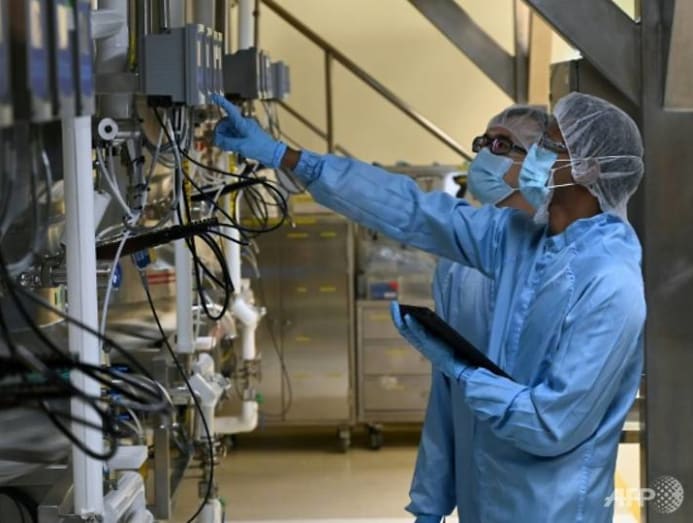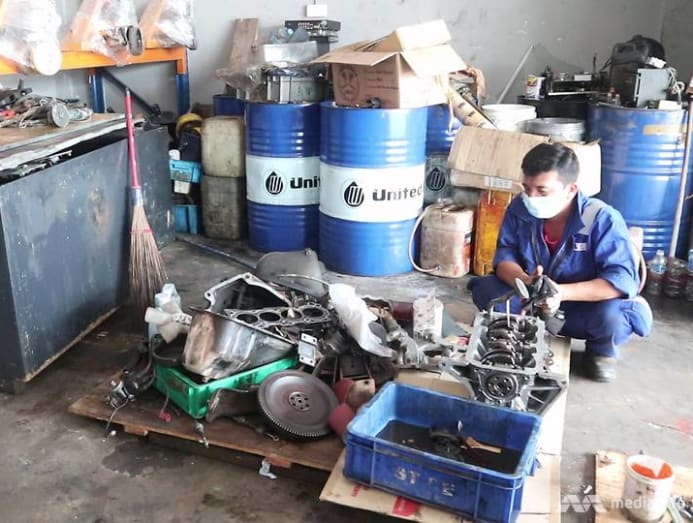Commentary: Contours of Singapore’s post-COVID economy are coming into sharper focus
SINGAPORE: What do papadums accept to exercise with a post-COVID Singapore economic system? Plenty, patently.
While much of the attending has been on the latest economic data which shows the Singapore economy is on a positive path to recovery, a curious instance of papadums reveal where those pockets of opportunity may lie.
Indeed, although it seems that recovery may exist uneven beyond sectors, the contours of Singapore'south mail service-COVID economy are coming into sharper focus – and it is vital for businesses to place how best to position themselves for the upturn.
READ: Commentary: Manufacturing remains central engine of Singapore economy. It just looks different
Overall, there are encouraging signs for the domestic economy. Singapore's Gross Domestic Production (GDP) grew by 0.2 per cent twelvemonth-on-yr in the start quarter of 2021, a turnaround from iii quarters of contraction, based on advance estimates by the Ministry building of Merchandise and Manufacture released on Apr 14.
It's still early on days but there is cautious optimism the Singapore economy is turning the corner out of the pandemic. Interestingly, the first quarter Gdp for 2022 is slightly higher than the same time last year, just before the circuit breaker.
DIGITALISATION FUELLING RECOVERY
Although economic recovery is narrow and express to a few sectors for at present, the momentum for growth is strong. Singapore'due south factory output expanded for a 5th direct calendar month, according to the monthly manufacturing performance information released by the Economic Development Lath (EDB) last month.
READ: Commentary: Why Singapore'due south travel restrictions volition keep changing for a while more
Never listen the slight turn down of 1.vii per cent in March since this was partially due to a weak global oil and gas market and travel restrictions – resulting in lower orders in the marine and offshore engineering and aerospace sectors.
The positive take-abroad is the potent drive for digitalisation, which saw electronic output go on to increase – 33.7 per cent in March 2022 from the same flow last year and 28.ane per cent on a year-to-date ground over the same period last year.
Some expert came out of the pandemic where companies were forced to pivot towards digitalisation and remote-working.
They are also embracing cloud services, information centres and 5G markets, which explains the stronger output in semiconductors, figurer peripherals and data storage segments.

Growth in these segments should pick up as digitalisation continues apace.
No dubiousness robust global semiconductor demand also drove strong growth in Singapore's exports, although trade in petrochemicals also underpinned this surge.
Non-oil domestic exports (NODX) also expanded 12.ane per cent year-on-year in March, with exports to China leading the stiff rebound at an increment of 46.four per cent from the previous month as the Chinese market demanded more specialised machinery, petrochemicals and primary chemicals.
This is significant as growth in petrochemicals exports is a bellwether for wider recovery and growth in other sectors around the world.
READ: Commentary: Could hydrogen be our solution to climatic change?
READ: Commentary: Manufacturing remains key engine of Singapore economy. It just looks dissimilar
Even so, sectors such equally transportation and storage run across connected weakness, still dilapidated by the travel restrictions brought most by the pandemic.
While countries take baby steps to establish travel bubbling and roll out vaccination of their population on a larger scale, the mass reopening of international borders is unlikely to happen this twelvemonth.
Sectors based on footfall, such as retail and food and beverage, are also likely to come across slower recovery, with the lack of tourists and shifts towards e-commerce.
The construction sector is currently supported by a pickup in public and individual sector construction activities.
However, challenges in manpower supply – particularly with contempo restrictions on labour from India due to the explosion in infections in that location – coupled with shortages in materials supply, and work arrangements with prophylactic distancing measures mean this sector will confront stiff headwinds.
Notwithstanding this, business sentiments are on the rise, and the highest since the pandemic began last twelvemonth, co-ordinate to the SBF-Experian SME Alphabetize (for the second and third quarter of 2021), a written report that measures forward-looking business sentiments of local SMEs.
(Listen to Singapore economists debate the trade-offs in choosing which sectors, companies and workers to assist during this COVID-19 downturn in CNA'due south Middle of the Affair published in August 2020:)
BUILDING RESILIENCE THROUGH DIGITALISATION AND TRANSFORMATION
And so what do these indicators mean for companies and sectors here?
The manufacturing, information and communications, finance and insurance sectors are expected to remain resilient for the rest of the twelvemonth, if current atmospheric condition agree.

This is in line with global trends and is unsurprising given that the pandemic has accelerated digitalisation across a broad range of sectors and businesses.
Moreover, 72 per cent of businesses with a high level of transformation are confident in sustaining their business organization over the next 12 months, according to the recent SBF National Business organization Survey conducted in October and Nov 2020.
I such company is Exceed Tech, an electronics manufacturer that designs and produces ultra-sensitive sensors targeting the industrial, telematics and healthcare markets.
Information technology successfully implemented a system to remotely track operations in its production facilities in Shenzhen, China from its headquarters in Singapore through the Industry iv.0 Human Majuscule Initiative (IHCI) Enabler Plan, a plan supported past Workforce Singapore.
READ: Commentary: Funding Singapore'south major infrastructure projects a catchy business
Its management achieved greater visibility of shopfloor operations, to make more informed decisions, leading to an increase in output by 21 per cent. The company also tapped on insights yielded by data, to improve the accuracy of its assembly line and reduce operational costs by shut to thirty per cent.
LOOKING BEYOND OUR SHORES
As the consign information shows, at that place are opportunities overseas that Singapore companies must seize despite the pandemic.
Caught up with day-to-mean solar day operations, internationalisation may be the furthest thing from the minds of SMEs. But with an open mind and the right mindset, they tin uncover unexpected opportunities.

So here's where papadums foretell the spicy story of Singapore's economic outlook.
Bhavani Stores worked closely with GlobalConnect@SBF, a programme supported by Enterprise Singapore, on a food hamper projection to showcase Singapore food products in Vietnamese supermarkets earlier this year during the Vietnamese New Year holiday.
This helped their Uncle Saba's Poppadoms brand of papadum snacks proceeds an initial foothold in Vietnam. The company is now in the process of bringing its "Poppadoms" to more than supermarkets in Vietnam through local distributors.
Right-SIZING MANPOWER
Notwithstanding, even as companies navigate these challenges and look to seize the opportunities ahead, the pandemic has also impacted jobs and workers in many ways.
Manpower-intensive sectors such as manufacturing, healthcare, F&B, and retail have had to grapple with labour shortages with the bear upon of travel restrictions on arrival of foreign manpower.
The jobs companies are looking to fill include service coiffure, cooks, drivers, factory operators and patient service associates. This shortfall is mainly in the S$two,000 to South$iii,000 salary band, in roles requiring repetitive tasks, like the operating of mechanism, client service and people skills.
The labour shortage has meant more job hopping and higher staff turnover for companies, plus higher costs, and is non expected to ease soon. Companies must look at transformation and task redesign to assist cope with the tight labour situation.

Every bit they digitalise and transform, companies must upskill staff, particularly rank and file workers, to handle more complex and cognitive-driven tasks. Workers must also move towards becoming more than multi-skilled to accept on more critical tasks.
READ: Commentary: Unclear if rebound shows economic recovery or a sign of persistent inflation
There are many government schemes available to back up companies and workers in upskilling, and companies and workers should make good apply of them.
The road to recovery is in sight. Our trade associations and business chambers stand ready to help our companies on their recovery and to seize new opportunities so equally to emerge stronger from the pandemic.
Lam Yi Immature is CEO of the Singapore Business organization Federation.
Source: https://cnalifestyle.channelnewsasia.com/commentary/commentary-contours-singapores-post-covid-economy-are-coming-sharper-focus-282441
Post a Comment for "Commentary: Contours of Singapore’s post-COVID economy are coming into sharper focus"